March 2001. A Few more images, including 2 Hi Res and large images showing
how things are going!.
For examples of flat fielding and dark frames see the bottom
of the page
March 2001
I have had a good winter. Warm and cosy inside, and better tracking and a
well behaved telescope. I have a few 600 sec guided Hi res images below....
They should give an idea of how things are going a year after permanent
mounting and 18 months after getting the camera.
It has been a bit frustrating.....especially when the clouds roll over after
9 minutes and ruin the image....but I can understand how some of the others,
whose images appear on the Web...only produce maybe 1 or 2 images a night!!

Stephan's Quintet:
This is a combined image of 6, 300 sec images
With no processing other
than automatically adjusting the background and levels with CCDOPS. It was
imaged using the F3.3 Reducer and in High Res. The image has been cropped.
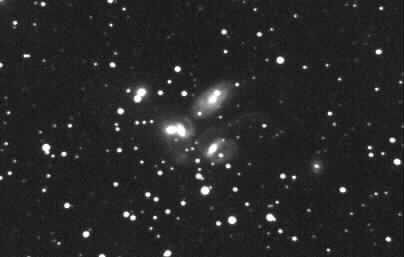
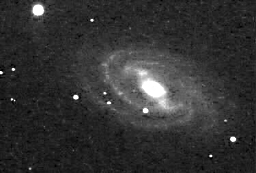 M109
M109
A track and accumulate image 12 x 60 secs at F10. Autodark and
Flatfielded.
Unsharp mask in Photoshop.
This is one of the first images I have taken with the permanent mount.
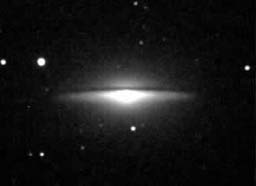 M104 The Sombero Galaxy
M104 The Sombero Galaxy
In Virgo at a distance of 65 Million Light years....
 M51 The Whirlpool Galaxy
M51 The Whirlpool Galaxy
In Canes Venatici....
Only 15 Million Light years away!
16 x 60 sec Track and Accumulate at F10
in Medium resolution
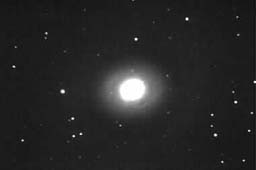 M94 The Croc's Eye Galaxy
M94 The Croc's Eye Galaxy
15 x 60 secs Track and Accumulate at F10 in Medium Resoultion
There is a lot of detail in that bright glow and when I ever figure out how
to process images I might get to see it!
Dark Frames and Flat Fields:
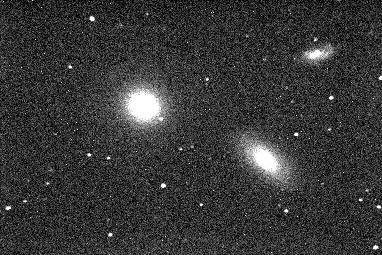 Here is a raw, uncorrected iamge of M105 in Leo......
Here is a raw, uncorrected iamge of M105 in Leo......
It contains dots which have nothing to do with the stars in the sky....the
dots are caused by CCD.
While the image is being taken some pixels receive
unwanted electrons from the electronics in the chip itself...the higher the chip
temperature the more electons the electrics generate...hence one of the reasons
we cool CCD Cameras...
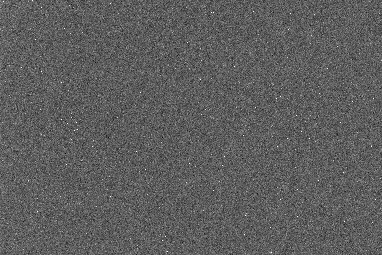 Here we have a dark frame...an image taken for the same length of
time, but with the shutter closed......this can be an automated process with
each image that you take...but then you spend half the time imaging the sky, and
the other imaging the back of the shutter....but you can take a series of dark
frames once the camera has reached it's operating temp...and save the dark
frames to subtract from you raw images later...when you are finished......
Here we have a dark frame...an image taken for the same length of
time, but with the shutter closed......this can be an automated process with
each image that you take...but then you spend half the time imaging the sky, and
the other imaging the back of the shutter....but you can take a series of dark
frames once the camera has reached it's operating temp...and save the dark
frames to subtract from you raw images later...when you are finished......
Can you see some of the electronically generated dots here and then
above........in the original
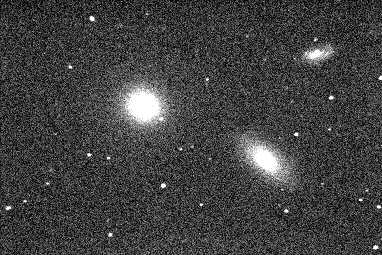 So we subtract one from the other....very easily done by the computer
and now we have an image free of electonic noise......
So we subtract one from the other....very easily done by the computer
and now we have an image free of electonic noise......
But that is not our only problem with CCD images...
Over the period the image is taken variation in intensity can effect the
image due to dirt/dust on the optics....or vingnetting due to focal
reducers....or in my case some light reflections due to nieghbours lights below
where I was imaging.....
It might not be obvious but it's there in the image..
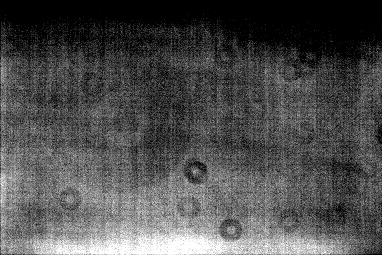 So before the evening starts I take an image (or series of
images...which I later add together and take a mean from the lot)..Called a Flat
Frame, and this is what this image looks like....loads of dust donoughts...and
darker at the top than at the bottom...(Actually....the bright band at the
bottom is due to the light being reflected off my dew shield....which is still
while cardboard...!!!!
So before the evening starts I take an image (or series of
images...which I later add together and take a mean from the lot)..Called a Flat
Frame, and this is what this image looks like....loads of dust donoughts...and
darker at the top than at the bottom...(Actually....the bright band at the
bottom is due to the light being reflected off my dew shield....which is still
while cardboard...!!!!
The flat field is taken around dusk...or against a white evenly illuminated
card....if I don't get started before dusk....(partners are handy for holding up
the card....children tend to wave them about)
They are only short images.....sometimes only 0.11 sec....and then they are
saved to disk....later to be used to correct the real 'important'
images......well......flat field and dark frames are important images in their
own right but I think you know what I mean....
Anyhow.....below is the result of dividing the image that has been dark
subtracted by the flat field......
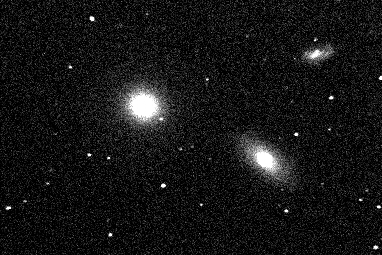 You might not think there is much of a difference beween this image
and the one above the flat field...but look again....this one is more even where
the one above shows the effects of the dark band at the top and the light band
near the bottom...
You might not think there is much of a difference beween this image
and the one above the flat field...but look again....this one is more even where
the one above shows the effects of the dark band at the top and the light band
near the bottom...
Have a good look and see if you can see what I mean..
Now...there you are, you understand flat fielding and dark frames....
Well there is a lot more to it but thats a start..
 M109
M109 M104 The Sombero Galaxy
M104 The Sombero Galaxy M51 The Whirlpool Galaxy
M51 The Whirlpool Galaxy M94 The Croc's Eye Galaxy
M94 The Croc's Eye Galaxy Here is a raw, uncorrected iamge of M105 in Leo......
Here is a raw, uncorrected iamge of M105 in Leo...... Here we have a dark frame...an image taken for the same length of
time, but with the shutter closed......this can be an automated process with
each image that you take...but then you spend half the time imaging the sky, and
the other imaging the back of the shutter....but you can take a series of dark
frames once the camera has reached it's operating temp...and save the dark
frames to subtract from you raw images later...when you are finished......
Here we have a dark frame...an image taken for the same length of
time, but with the shutter closed......this can be an automated process with
each image that you take...but then you spend half the time imaging the sky, and
the other imaging the back of the shutter....but you can take a series of dark
frames once the camera has reached it's operating temp...and save the dark
frames to subtract from you raw images later...when you are finished...... So we subtract one from the other....very easily done by the computer
and now we have an image free of electonic noise......
So we subtract one from the other....very easily done by the computer
and now we have an image free of electonic noise...... So before the evening starts I take an image (or series of
images...which I later add together and take a mean from the lot)..Called a Flat
Frame, and this is what this image looks like....loads of dust donoughts...and
darker at the top than at the bottom...(Actually....the bright band at the
bottom is due to the light being reflected off my dew shield....which is still
while cardboard...!!!!
So before the evening starts I take an image (or series of
images...which I later add together and take a mean from the lot)..Called a Flat
Frame, and this is what this image looks like....loads of dust donoughts...and
darker at the top than at the bottom...(Actually....the bright band at the
bottom is due to the light being reflected off my dew shield....which is still
while cardboard...!!!! You might not think there is much of a difference beween this image
and the one above the flat field...but look again....this one is more even where
the one above shows the effects of the dark band at the top and the light band
near the bottom...
You might not think there is much of a difference beween this image
and the one above the flat field...but look again....this one is more even where
the one above shows the effects of the dark band at the top and the light band
near the bottom...